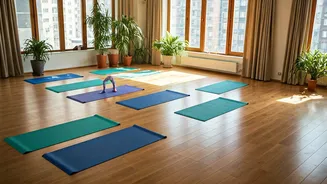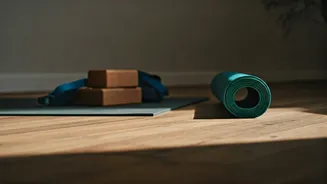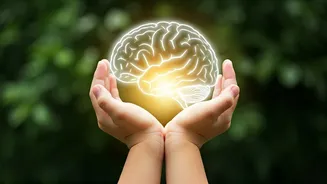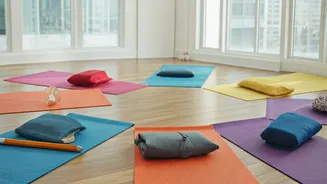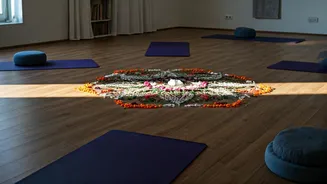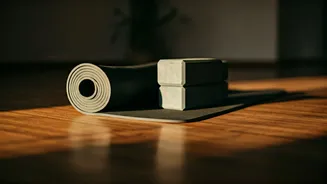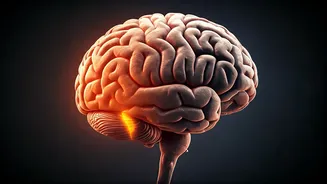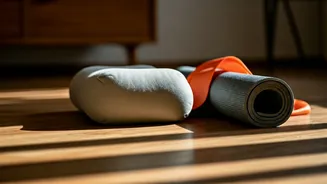Child's Pose
Child's Pose, known as Balasana, is an excellent starting point for any yoga session, especially for children. It's a calming pose that gently stretches
the hips, thighs, and ankles while easing stress and fatigue. To perform this pose, instruct the child to kneel on the floor with their big toes touching. Then, they should spread their knees hip-width apart and exhale as they bend forward, resting their torso between their thighs. The arms can be extended forward or relaxed alongside the body. Encourage them to stay in this position for several breaths, focusing on their breath and allowing their body to relax completely. This pose provides a sense of security and relaxation, preparing the mind and body for the yoga session ahead. The gentle compression on the abdomen can also aid in digestion, making it a great pose to include after a meal. It promotes a feeling of safety and comfort, and it's a fantastic way to encourage a child to find inner peace, which enhances their ability to focus and remember information.
Mountain Pose
Tadasana, or Mountain Pose, might seem simple, but it is a foundational posture that teaches children about balance, posture, and body awareness. To begin, have the child stand with their feet together, or slightly apart, their arms at their sides, and palms facing forward. They should lift their chest, gently pull their shoulders back, and lengthen their spine. Instruct them to engage their core muscles, imagine a string lifting them from the crown of their head to the ceiling, and breathe deeply. This pose is not merely about standing still; it is about cultivating a sense of groundedness and stability. The Mountain Pose enhances focus by teaching children to be present in their bodies and to pay attention to the alignment of their bodies. Encourage children to visualize themselves as a strong, tall mountain, unyielding and firm. The emphasis on proper posture improves body awareness, which contributes to greater mental focus and concentration. By regularly practicing this pose, children can learn to maintain balance and enhance their body's capacity to remain still, which in turn benefits memory.
Downward Dog
Adho Mukha Svanasana, or Downward-Facing Dog, is an energizing pose that boosts blood flow to the brain, which in turn can improve cognitive functions. It challenges the child to concentrate on their form and maintain balance. To get into this pose, instruct the child to start on their hands and knees, then lift their hips toward the ceiling. Their body should form an inverted V-shape, with their hands shoulder-width apart and their feet hip-width apart. They should press their palms firmly into the ground and lengthen their spine, aiming to make their body one long line from their hands to their hips. Remind them to keep their head between their arms and let their gaze drift towards their toes. Holding this pose gently stretches the entire body, from head to toe, reducing tension and fatigue. The increased blood flow supports brain function, helping to stimulate memory and sharpen concentration. The Downward-Facing Dog pose fosters a sense of strength and confidence, allowing kids to improve their focus and concentration skills.
Warrior Pose
Virabhadrasana, or Warrior Pose, comes in multiple variations, and each version offers benefits for children, including improved balance, coordination, and mental focus. For the simplest version (Warrior I), have the child stand with their feet wide apart, turn one foot out 90 degrees and the other in slightly. Bend the front knee over the ankle, keeping the back leg straight. Raise their arms overhead, palms facing each other, and gaze upwards. Encourage them to feel strong and confident. This pose builds physical strength and stamina while also helping children learn to concentrate on a single point to maintain balance. As they hold the pose, they learn to focus their attention, which directly benefits their memory and focus. Variations of the Warrior Pose can add to the challenge and provide opportunities to improve body awareness and spatial reasoning. Regular practice of the Warrior Pose improves children's ability to focus, contributing to better memory and overall cognitive performance.
Tree Pose
Vrksasana, or Tree Pose, is a balance-oriented posture that is fantastic for improving focus and concentration in children. To perform this pose, have the child stand tall, placing the sole of one foot on the inner thigh or calf of the other leg (avoiding the knee). Ensure that their standing leg is straight. Bring their hands together in front of their chest in a prayer position (Anjali Mudra). Encourage them to find a fixed point to gaze at to maintain balance. The Tree Pose develops a child's sense of balance and coordination. The challenge of maintaining the pose necessitates intense focus, and this practice directly strengthens the ability to concentrate. This focus will, in turn, help improve their memory and their ability to learn. Remind the children to breathe deeply and to try to stay steady like a tree, strong and rooted. This pose provides an opportunity for children to cultivate patience and self-control while enhancing their physical and mental balance. The constant need for attention helps the mind stay present, making it easier to recall information.
Cobra Pose
Bhujangasana, or Cobra Pose, stretches the spine and stimulates the abdominal organs, which can contribute to overall well-being and brain function. Have the child lie on their stomach with their hands under their shoulders and elbows close to their body. Gently lift their chest off the ground, using their back muscles. The child should only lift as far as is comfortable, and keep their shoulders relaxed. Encourage them to gaze forward and breathe deeply, expanding the chest. The Cobra Pose helps to boost energy levels, which may help enhance memory and cognitive performance. It stretches the spine, promoting improved posture and body awareness. This pose also helps to relieve stress and tension, creating an environment that encourages focus and concentration. By incorporating the Cobra Pose into the yoga routine, children can better manage their stress levels, helping them to focus and retain information.
Bridge Pose
Setu Bandhasana, or Bridge Pose, improves blood flow to the brain and can calm the mind, supporting better memory and concentration. Instruct the child to lie on their back with their knees bent and feet flat on the floor, hip-width apart. Place their arms along their sides with palms facing down. Lift their hips off the floor, forming a bridge with their body. They can clasp their hands together under their back for support. Keep their chin tucked slightly towards the chest. Encourage them to breathe deeply. This pose stimulates the thyroid gland, which can influence energy levels and mental clarity. It improves blood circulation, supporting better cognitive function. The Bridge Pose promotes relaxation and can counteract the effects of stress, creating an environment conducive to learning and remembering. Regular practice helps children to improve their concentration and to better manage their emotions. This pose also strengthens the back, which is beneficial for overall physical health.
Boat Pose
Paripurna Navasana, or Boat Pose, is a core-strengthening pose that challenges balance and builds mental focus. Have the child sit on the floor with their knees bent and feet flat on the ground. Lean back slightly, engaging their core muscles, and lift their feet off the floor, keeping their shins parallel to the ground. They should extend their arms forward parallel to the floor, or extend them overhead for a more difficult pose. The Boat Pose requires concentration and control, directly enhancing the ability to focus. As children work to maintain the pose, they build body awareness, coordination, and strength, all of which contribute to better cognitive function. This pose not only strengthens the core but also stimulates the abdominal organs, contributing to overall health. Encouraging deep breaths throughout the pose helps children remain centered and better able to concentrate. The challenge of the Boat Pose can be adapted to accommodate different skill levels, which makes it engaging and beneficial for children of all ages.
Butterfly Pose
Baddha Konasana, or Butterfly Pose, is a gentle hip opener that also calms the mind, creating a better environment for learning and memory. To perform this pose, have the child sit on the floor with their legs extended. Bend their knees and bring the soles of their feet together, as close to their groin as is comfortable. Hold their feet and gently flap their knees up and down like butterfly wings. Encourage them to sit tall and breathe deeply. The Butterfly Pose helps in relieving stress and tension, which are common barriers to learning and concentration. It encourages relaxation and can enhance blood circulation, supporting brain function. This pose is particularly effective in calming the mind and preparing the body for more focused activity. The gentle rocking motion can also be soothing, which makes it a fun and accessible pose for children. The pose helps to improve flexibility and release any tension in the hips, which can promote a greater sense of calm and a positive mindset.
Corpse Pose
Savasana, or Corpse Pose, is a crucial part of any yoga session, as it provides an opportunity for the body and mind to relax and integrate all the benefits of the other poses. Have the child lie flat on their back, with their arms at their sides, palms facing up, and legs slightly apart. Encourage them to close their eyes and relax their entire body, from their toes to the top of their head. Guide them to breathe deeply and slowly. The Corpse Pose helps to reduce stress and anxiety, creating a state of mental clarity that benefits memory and focus. It allows the body to fully absorb the benefits of the yoga practice, promoting relaxation and rejuvenation. Encourage the children to let go of any tension and simply observe their breath. This pose teaches them the importance of stillness and mindfulness, which are critical for enhancing memory and improving their overall ability to focus. The Corpse Pose allows a child to rest and reflect, preparing them for the day ahead.
